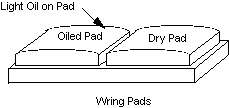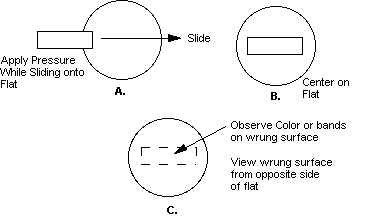There is a formal test for wringability as described below. This test may be done by the user of
the blocks, and does not require a laboratory to perform the test. This test is usually only
done if a problem with a block is suspected.
To test gage blocks for wringability, a 2 Inch Diameter, Reference Grade (1 microinch flatness)
Quartz Optical Flat should be used. A Double Sided Flat is recommended if more than 40
blocks are to be tested. (A double-sided flat does not add to the accuracy of measurement. It
provides a second wringing surface if the first surface becomes scratched while wringing blocks
to the flat.)
1. Prepare the blocks for wringing. Make sure the blocks are free of nicks and burrs. Lightly
stone the blocks as necessary. (See Stoning gage blocks under Use and Care.) Make
sure the blocks are thoroughly cleaned.
2. Wipe the surface of the Optical Flat gently across an oiled Wring Pad.
3. Wipe the surface of the flat gently across the dry pad.
4. Slide the test block onto the flat as shown. Apply pressure while sliding the block and flat
together.
5. Observe the surface of the gage block that is wrung to the Optical Flat from the opposite side
of the flat. Repeat this step as necessary to ensure a valid result.
6. Interpret results:
a. For B89 Grades K, 00, and 0, and GGG Grades 0.5, 1, and 2,, no color or oil should
appear on the face of the flat.
b. For B89 Grades AS1 and AS2 or GGG Grade 3, the surface shall not have less than
80% colorless wringing area.
7. Repeat for the other surface of the test block.
|
|
|

